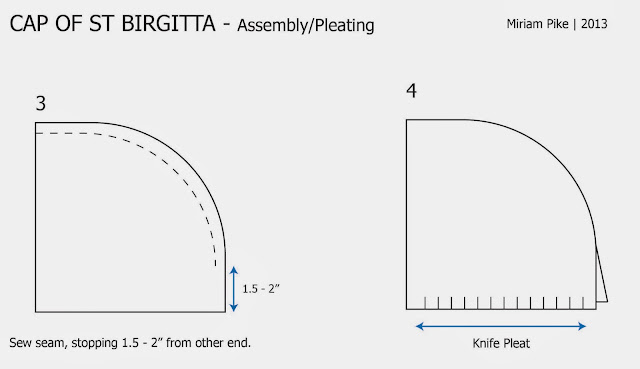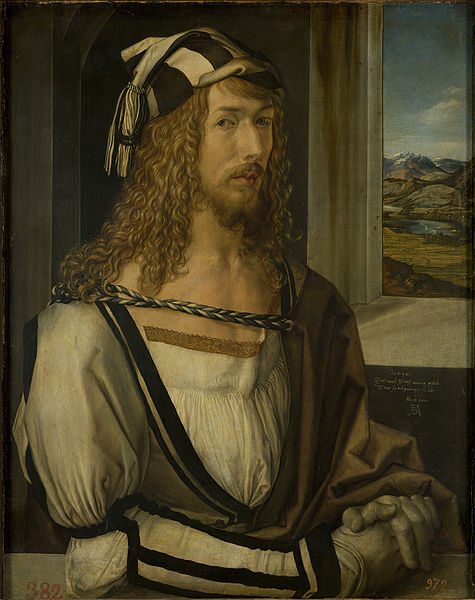I love this cap, it is perfect to wear on its own or under hats and veils. It keeps my hair clean all weekend (if I wear it) and helps my outfits look "right". If you have any questions, please leave comments!
 |
| The author and Amya Weaver (Caid) wearing my first two attempts at the making the cap |
1. Cap - First cut 2 squares of your linen. For a generic cap, I cut 10.5-10.75" squares for a small, 10.75-11" for a medium and 11-11.25" for a large head.
To cut based on your head measurement, measure your head around with the measuring tape going from your hairline in front (forehead) to the nape of your neck (this is where the cap will sit when being worn). Divide this number in half and add .5” for seam allowance.
Example: My head is 20.5” (20.5/2) + .5 = 10.75 - I normally wear a women's small in hats.
NOTE: Your two pieces do not have to be perfectly square. Two rectangles of the same size will also work (especially if you have short or thin hair). If you do go with a rectangle, the long side should be oriented upright to follow this diagram.
Ties/Loop - Cut about 60-70 inches of 2 inch wide strips for the ties. If you have to cut several lengths to get sufficient length, sew the ends together to make one long strip.
2 Now round one corner of both pieces as shown above. This does not have to be a perfect curve, but try to avoid sharp turns.
3 Sewing - Sew both sides of the cap together along the edge you have just curved as shown. Start at the edge on one side and stitch down to 1.5-2” from the edge on the other side. Finish this seam by pressing the seam allowance away from the seam on each side and sewing down.
Optional Embroidered Seam: The extant cap has an inset embroidery replacing this seam that connects the two halves. If you want to try this out, work your embroidery stitch in place of the seam. Check out how these tutorials for the embroidery:
Sarah's Hand Embroidery Tutorials (color coded!)
Elysa's Endeavors (really nice, clear drawings of the embroidery)
For information on how to pleat fabric and other options for pleats, try the Elizabethan Costuming Page
1) fold the edge over on each side by about 1/4 inch and iron
2) fold the strip in half and iron again.
Once that is done, pin the tie/loop around the raw edge of the cap, and begin stitching it down. I usually start at the center front and stitch one side and then the other. If you have not yet rounded the corner at the front of the cap, you will need to do that as you sew on the tie. Stop stitching once you reach the gap at the back of the cap after the pleats. Sew the ties down on the other side of the cap (starting from the center front) the same as the first side.
7 Finishing - When you are done with that side, try on the cap and figure out the length your ties need to be. To try on your cap, the ties should crisscross in back of your head under your bun/hair, and cross to your forhead at the front of the cap. There they crisscross and the last loop lays on the back of your head over your hair The key to this cap is a fairly snug fit. Linen stretches when warm so it will loosen gradually as you wear it. This is fairly easy to make smaller later if you need to change the size. Pin the ends of the ties together once you have found a length that works for you. Take the cap off and sew the ends of your ties together at the point you marked. Now sew the tie closed along the length of the tie.
Wearing the Cap
 |
| Left: Sleeves GFD over long-sleeved shift with cap. Middle: Red overgown over green GFD, or gothic fitted gown. Right: Another view of the plain cap (Baronial A&S) |
Since the cap spans a range of several centuries, you have a fairly broad range of things to wear it with. I generally wear my cap with my 14th/15th century garb as it completes the outfit so well. I generally braid my hair in two braids and either pin or sew it back and forth at the back of my head to fill out the cap. I have put my hair up in a straight bun before, but I find it pokes the cap out at the back, rather than filling it out nicely.
Over the Cap?
 |
| Left: 14th century cotehardie with cap and veil. Middle: Working class Flemish outfit (1570s) with cap and a flat cap on top. Right: Working Class Flemish with straw hat over cap. |
The cap also makes a fabulous foundation layer for other headgear. In addition to being worn on their own, caps were worn under veils (as seen in these Italian images) and hats. With a couple of hat pins/straight pins at the ready, you are all set!
Links and Sources:
-Dahl, C.L. & I. Sturtewagen, 2008, The Cap of St. Birgitta, Medieval Clothing and Textiles vol. IV, pp. 99-129
- Medieval Silk Work - Women's Caps
-More of my Cap of St Birgitta images on Pinterest
P.S. I love seeing finished caps! So link to yours if you have pics.
Follow Miriam Pike Cap of St Birgitta on Pinterest


















